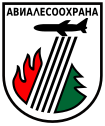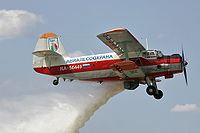Awialessoochrana
| Awialessoochrana - Авиалесоохрана - |
|
|---|---|

|
|
| Professional fire brigade | |
| Founding year: | 1931 |
| Employee: | approx. 4000 |
| www.aviales.ru | |

Awialessoochrana ( Russian Авиалесоохрана , German: Air protection of the forests or aerial surveillance of the forests) is the name of a Russian special fire department , the oldest and largest forest fire fighting unit in the world. The troops are responsible for fighting forest and steppe fires, protecting against insect damage and other dangers throughout the Russian territory, which is home to a quarter of the world's forests and between 20,000 and 35,000 fires every year.
Around 4,000 firefighters, spread over 18 airfields and 340 smaller locations, serve in this force. The unit's headquarters are located in Pushkino near Moscow. For use, the units are either flown with Mi-8 helicopters or they jump from An-2 double-deckers with parachutes . At a few locations they are supported by the local population. In remote operational areas, the Awialessoochrana is the only unit that is able to fight the source of the fire. Fires in the vast expanses of Russia are often left to their own devices .
history
Awialessoochrana has its origin in the 1920s. At this time, aircraft began to be used in the USSR for aerial mapping and forest control. Forest fires were also repeatedly discovered during these flights. Awialessoochrana owed its foundation to this fact in July 1931, eight years earlier than the corresponding smoke jumper units in the USA .
At the beginning, the first test flights to localize forest fires took place in the Nizhny Novgorod Oblast . The official first flight took place on July 7, 1931, the day the Awialessoochrana was founded, in a Polikarpow U-2 . It lasted 1.5 hours. During the entire mission time of about 40 hours, an area of 15,000 square kilometers was controlled and 14 fires were discovered. In the years that followed, these flights were also carried out in Karelia, the Urals and the Far East and there were a large number of studies on whether and how the use of aircraft in fire fighting could be optimized. One of the results was the training of 17 first with parachutes equipped Smoke Jumper in 1935th
By 1939, in addition to Nizhny Novgorod, three more air bases had been opened in Arkhangelsk , Perm and Krasnoyarsk , and the forest area to be controlled increased steadily, as did the flight hours. At the beginning of the Second World War , 110 U-2 aircraft and 70 fire jumpers controlled an area of 109,000 square kilometers. When fighting broke out between the German Reich and the Soviet Union in 1941, all activities of the Awialessoochrana ceased and the pilots and planes were deployed at the front. The work did not continue until a few years after the end of the war. In 1951, a school for the regular training of fire jumpers was founded in Chomjakowo near Moscow. From 1952 the Antonow An-2 took over the tasks of the U-2. In contrast to the An-2, however, the An-2 was able to carry several fire jumpers at the same time during patrol flights, which could be used immediately if a fire was discovered. This significantly increased the effectiveness of fire fighting. The An-2 still make up a large part of the Awialessoochrana aircraft fleet. Nowadays they are being converted to more modern An-3s by installing turboprop engines. Helicopters such as the Mil Mi-1 and Mi-4 were added later, which the firefighters lowered to the ground using rope winches or landed next to the fire. In 1960, special jump suits were developed, thanks to which the fire jumpers could also be set down directly over forest areas. Larger groups of fire jumpers were dropped off from multi-engine aircraft such as the Ilyushin Il-14 , the An-26 or the large helicopter Mi-6 . This tactic was increasingly used in the 1980s.
Until 1990, the aircraft were hired for surveillance from different airlines that used the same airfields. At that time, more than 8,000 firefighters were working at Awialessoochrana, making it the largest fire department in the world. After the collapse of the Eastern Bloc, their number shrank to 4,000 due to the radical budget cuts. The aircraft could no longer be rented and from 1994 onwards, their own aircraft fleets were created, whose machines were taken over by Aeroflot , which was also struggling with financial difficulties . Due to these limitations, the effectiveness of the fire fighting decreased massively. In the 2000s, only about 40% of all forest fires were localized, and Awialessoochrana was only involved in 19% of the extinguishing measures. The unit had to make do with a very small budget (2001: 35 million euros). Equipment was often out of date and wages were low. However, if the firefighters put out fires within two days, they received a bonus payment. In 1972 and 2002, when the worst forest fires threatened the capital Moscow , firefighters from the Awialessoochrana were flown in from all parts of the country and played a key role in successfully fighting the fires. 2001 marked the 70th anniversary of the first flight.
In 2007, responsibility for forest protection was transferred to the regions, and the Awialessoochrana facilities came under the responsibility of the regional authorities. According to the environmental foundation WWF, the associated drastic reduction in fire-fighting funds has greatly increased the forest fire problem in Russia.
Web links and sources
- Awialessoochrana (Russian, English, Italian, Spanish)
- Avialesookhrana Information Server (Russian, English)
- Pictures of Aerial Forest Protection Service airplanes and helicopters (English)
- Pictures and further information (English)
- Articles about Aerial Forest Protection Service on NationalGeographic.com (English)
- Fire jumpers in Siberia - Documentation about the deployment of the Awialessoochrana in Siberia.
- WWF: Inadequate forest management aggravates Russian forest fire ferno